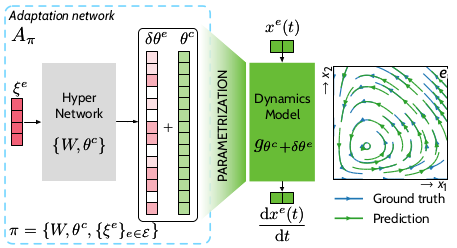Physics-Guided Machine Learning
Work in progress
In what follows, we distinguish two cases wether the PDE describing the underlying dynamic is known or not.
1. Models
PINNs [Raissi et al., 2018] PDE-known. This paper first introduced the concept of Physics-Informed Neural Networks (PINNs). Instead of resorting to numerical PDE solvers, the originality of this work is to train a neural network to predict the solution of a known PDE at any spatio-temporal point. More formally, it relies on a neural network \(f_\theta\), with parameters \(\theta\), whose goal is to map \([x,t]\) to the solution \(u([x,t])\) of the PDE at \([x,t]\). The parameters \(\theta\) are trained so that three conditions are met:
- The PDE is satisfied
- The boundary conditions (BC) are satisfied
- The initial conditions (IC) are satisfied
In practice, \(\ell_2^2\) residuals (i.e., MSEs) are computed on some pre-defined spatio-temporal points to quantify, to what extents, each of the condition is satisfied. As such, \(\theta\) is found so that the sum of \(\mathcal{L}_{\rm PDE}\), \(\mathcal{L}_{\rm BC}\) and \(\mathcal{L}_{\rm IC}\) is minimized
APHYNITY [Yin et al., 2021] PDE-partly-known.
FNO [Li et al., 2021] PDE-unknown. Fourier Neural Operators (FNO)
2. Meta-Learning
CoDA [Kirchmeyer et al., 2022] PDE-unknown. The COntext-informed Dynamics Adaptation (CoDA) method …

References
- [Kirchmeyer et al., 2022] M. Kirchmeyer, Y. Yin, J. Donà, N. Baskiotis, A. Rakotomamonjy and P. Gallinari. "Generalizing to new physical systems via context-informed dynamics model". Proceedings of the International Conference on Machine Learning (ICML) (2022)
- [Kirchmeyer et al., 2022] M. Kirchmeyer, Y. Yin, J. Donà, N. Baskiotis, A. Rakotomamonjy and P. Gallinari. "Generalizing to new physical systems via context-informed dynamics model". Proceedings of the International Conference on Machine Learning (ICML) (2022)
- [Raissi et al., 2018] M. Raissi, P. Perdikaris and G.E. Karniadakis. "Physics-informed neural networks - a deep learning framework for solving forward and inverse problems involving nonlinear partial differential equations". Journal of Computational Physics (2018)
- [Yin et al., 2021] Y. Yin, V. Le Guen, J. Dona, E. de Bézenac, I. Ayed, N. Thome and P. Gallinari. "Augmenting physical models with deep networks for complex dynamics forecasting". Journal of Statistical Mechanics - Theory and Experiment (2021)